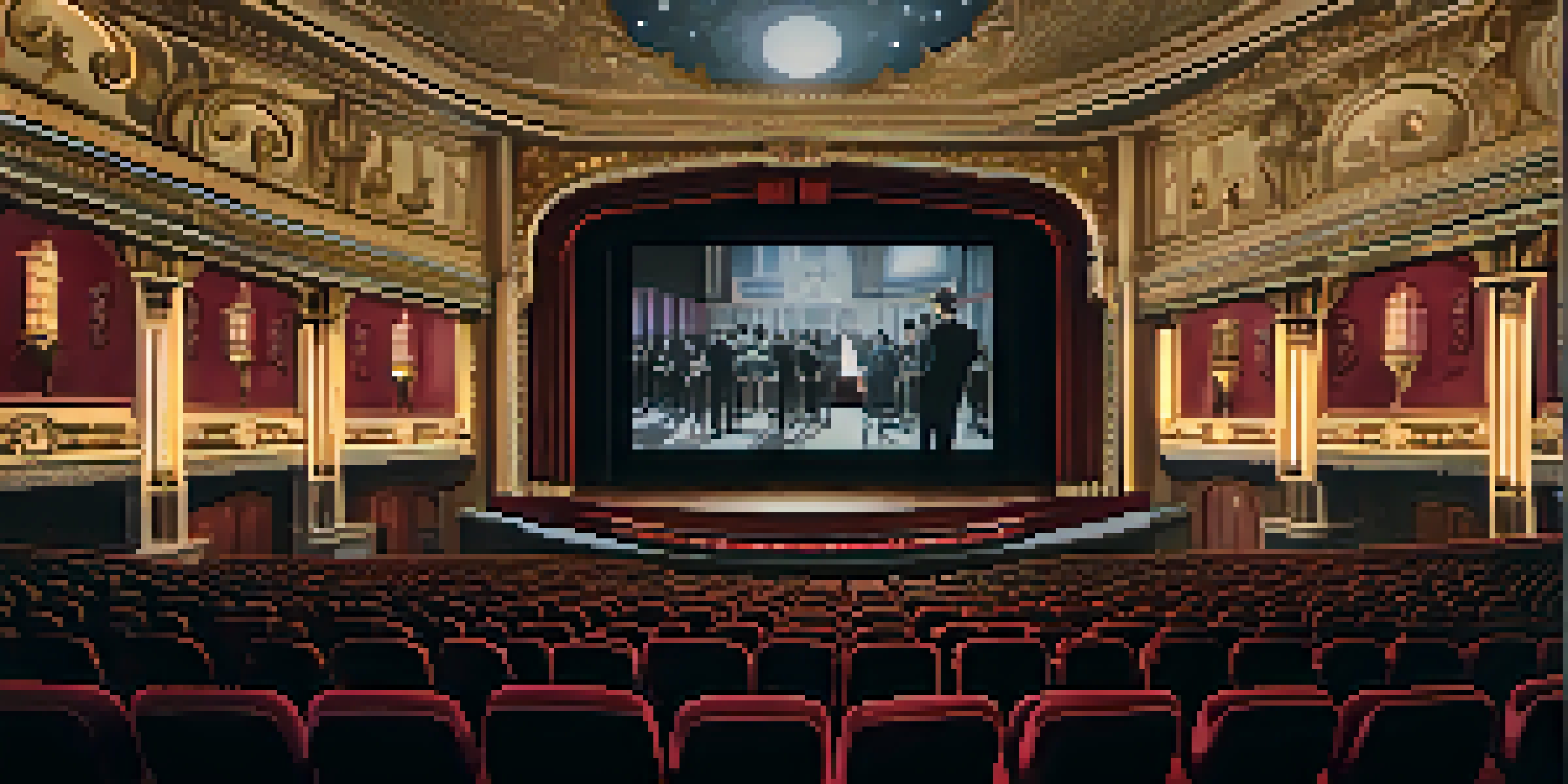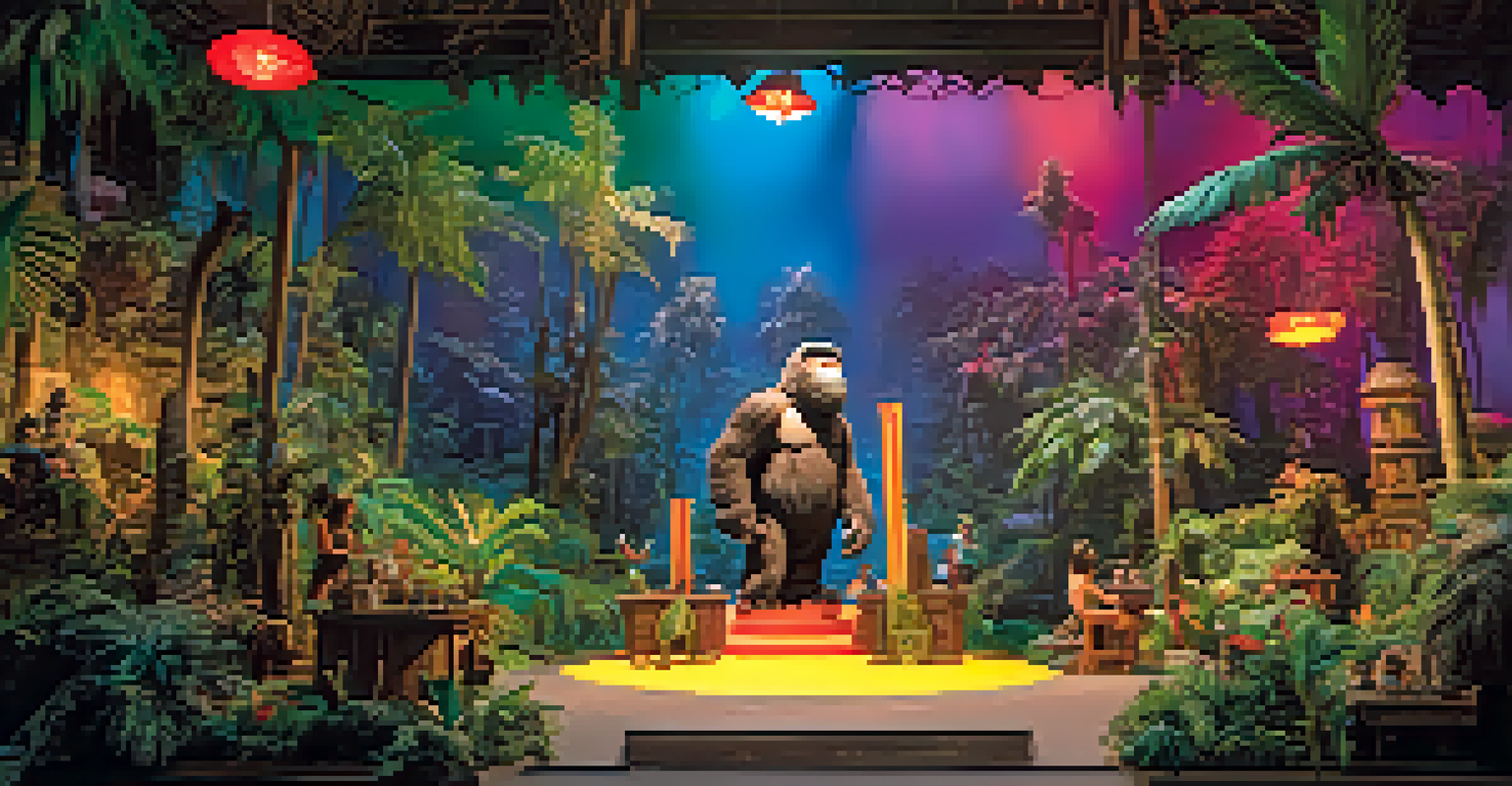The Evolution of Visual Effects in Film: A Historical Overview

The Beginnings of Visual Effects in Early Cinema
Visual effects have been enchanting audiences since the dawn of cinema. Early filmmakers like Georges Méliès used practical effects, like trick photography and stagecraft, to create magical illusions. One of his most famous works, 'A Trip to the Moon' (1902), showcased how imagination could transform simple scenes into captivating stories. This era laid the groundwork for the creative possibilities that visual effects could offer in film.
The special effects are a way to make the impossible possible and create a world where imagination reigns supreme.
These early techniques, while rudimentary by today’s standards, were revolutionary at the time. Filmmakers relied on in-camera tricks, such as double exposures and stop-motion, to create compelling narratives. Such innovations sparked the imagination of not only directors but also audiences, who were dazzled by the new world of possibilities. As the 20th century progressed, the demand for more sophisticated effects grew, pushing filmmakers to explore new technologies.
This exploration marked the beginning of a long journey in visual effects. The merging of storytelling with visual creativity became an essential element of filmmaking. It set the stage for further advancements and experimentation that would follow, ultimately revolutionizing how stories were told on screen.
The Golden Age of Hollywood and Practical Effects
The Golden Age of Hollywood (1927-1960) was a pivotal moment for visual effects, characterized by the rise of practical effects. Films like 'King Kong' (1933) showcased groundbreaking techniques, such as stop-motion animation and miniatures, to bring larger-than-life creatures to the big screen. These practical effects were painstakingly crafted, requiring immense skill and creativity, and they captured the audience's imagination.

During this era, filmmakers began to understand the importance of blending special effects with storytelling. The use of matte paintings and rear projection provided filmmakers with the tools to create immersive environments while keeping the audience engaged. This period highlighted a synergy between artistry and technology that would define visual effects for decades to come.
Visual Effects Evolve Through Time
From early practical effects to modern CGI, visual effects have continually transformed the storytelling landscape in cinema.
As audiences flocked to theaters, the demand for visually stunning stories continued to grow. This led to a competitive landscape where studios pushed the boundaries of what was possible. The innovations from this period laid the foundation for future advancements, as filmmakers sought to elevate the cinematic experience.
The Rise of Optical Effects and the 1960s Innovations
The 1960s brought a wave of innovation with the rise of optical effects, which transformed how filmmakers approached visual storytelling. Techniques such as matting and compositing allowed for more complex visuals, enabling filmmakers to blend different elements seamlessly. Iconic films like '2001: A Space Odyssey' (1968) utilized these techniques to create stunning visuals that were ahead of their time.
Visual effects are not just about making things look good; they enhance storytelling and engage the audience's imagination.
This era marked a clear transition towards a more technical approach in visual effects. Filmmakers began to experiment with new optical technologies, pushing the limits of what could be achieved on screen. The introduction of blue and green screens revolutionized the way scenes were shot, allowing for greater flexibility in post-production.
As filmmakers embraced these advancements, audiences were treated to increasingly complex narratives. The combination of storytelling and technological innovation captivated viewers, showcasing the endless possibilities of visual effects. This momentum would only build as new technologies emerged in the following decades.
The Advent of Computer-Generated Imagery (CGI)
The 1990s marked a seismic shift in visual effects with the introduction of computer-generated imagery (CGI). Films like 'Jurassic Park' (1993) demonstrated the power of CGI to create lifelike creatures, setting a new standard for visual effects in cinema. This leap in technology not only expanded creative possibilities but also allowed filmmakers to visualize concepts that were previously unimaginable.
CGI quickly became an integral part of the filmmaking process, blending seamlessly with practical effects to create immersive worlds. The ability to create entire landscapes and characters through CGI transformed storytelling, leading to epic blockbusters like 'The Matrix' (1999) and 'Avatar' (2009). This evolution redefined the relationship between technology and storytelling, making visual effects a critical component of modern cinema.
Digital Technology Democratizes Filmmaking
The rise of affordable digital tools has empowered independent filmmakers to create stunning visual narratives on smaller budgets.
As CGI continued to advance, it opened doors for innovation in animation and live-action films alike. Viewers were now accustomed to seeing stunning visuals that enhanced narrative depth. The rise of CGI marked a new chapter in the evolution of visual effects, paving the way for an era where the line between reality and fantasy became increasingly blurred.
The Impact of Digital Effects in the 21st Century
Entering the 21st century, digital effects became the cornerstone of visual storytelling. The advancement of software and technologies allowed for unprecedented detail and realism in effects. Movies like 'The Lord of the Rings' series showcased how digital effects could enhance epic storytelling, creating entire worlds that felt both authentic and fantastical.
The rise of digital technology also democratized visual effects, allowing independent filmmakers to create stunning visuals on smaller budgets. With tools like Adobe After Effects and Blender becoming more accessible, creativity flourished across various platforms. This shift empowered a new generation of filmmakers to experiment with effects and tell their stories in innovative ways.
However, the reliance on digital effects also sparked debates about the balance between technology and artistry. As filmmakers navigated this landscape, the challenge remained to use effects to enhance storytelling rather than overshadow it. This ongoing dialogue about the role of visual effects in cinema continues to shape the industry today.
The Future of Visual Effects: Trends and Innovations
As we look ahead, the future of visual effects is brimming with possibilities. Technologies like virtual reality (VR) and augmented reality (AR) are beginning to influence how stories are told, creating immersive experiences that draw audiences deeper into narratives. Films are exploring new formats that blend live-action with interactive elements, offering viewers a chance to engage with stories like never before.
Advancements in artificial intelligence (AI) are also set to revolutionize visual effects. AI can streamline processes, allowing for faster rendering times and more efficient workflows. This means filmmakers can focus more on creativity and storytelling, rather than getting bogged down in technical challenges. The fusion of AI with traditional techniques could lead to groundbreaking innovations that redefine visual effects.
Cultural Impact of Visual Effects
Visual effects not only enhance films but also shape cultural narratives and representation, influencing audiences and industries worldwide.
Moreover, the conversation around sustainability in filmmaking is gaining traction. As the industry seeks to reduce its carbon footprint, the development of eco-friendly visual effects technologies will likely play a crucial role. This commitment to sustainable practices, combined with ongoing technological advancements, promises an exciting future for visual effects in film.
The Cultural Impact of Visual Effects in Film
Visual effects have not only transformed filmmaking but also shaped cultural narratives. Iconic scenes and characters born from visual effects have become ingrained in popular culture, influencing everything from fashion to gaming. The impact of films like 'Star Wars' and 'Avatar' extends beyond the screen, creating a legacy that resonates with audiences worldwide.
Moreover, visual effects have the power to tell diverse stories that reflect different cultures and experiences. As the industry continues to evolve, there is a growing emphasis on representation in visual storytelling. This shift enables filmmakers to explore and celebrate various perspectives, enriching the cinematic landscape.

As technology continues to advance, the potential for visual effects to drive cultural change is immense. Films can challenge societal norms, provoke thought, and inspire action. The evolution of visual effects is not just about technology; it’s about the stories they help tell and the impact they have on our world.